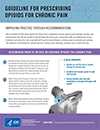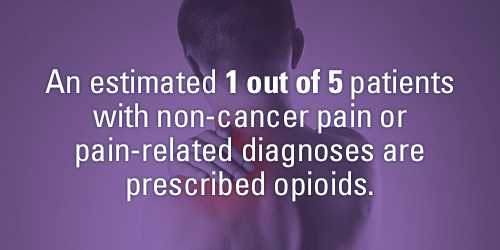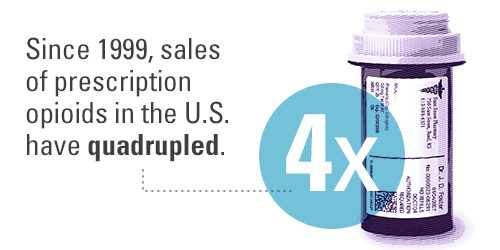CDC Guideline for Prescribing Opioids for Chronic Pain
Improving the way opioids are prescribed through clinical practice guidelines can ensure patients have access to safer, more effective chronic pain treatment while reducing the number of people who misuse, abuse, or overdose from these drugs.
CDC developed and published the CDC Guideline for Prescribing Opioids for Chronic Pain to provide recommendations for the prescribing of opioid pain medication for patients 18 and older in primary care settings. Recommendations focus on the use of opioids in treating chronic pain (pain lasting longer than 3 months or past the time of normal tissue healing) outside of active cancer treatment, palliative care, and end-of-life care.
Improving the way opioids are prescribed through clinical practice guidelines can ensure patients have access to safer, more effective chronic pain treatment while reducing the risk of opioid use disorder, overdose, and death. Nearly 2 million Americans, aged 12 or older, either abused or were dependent on prescription opioids in 2014.
- An estimated 11% of adults experience daily pain
- Millions of Americans are treated with prescription opioids for chronic pain
- Primary care providers are concerned about patient addiction and report insufficient training in prescribing opioids
The CDC Guideline addresses patient-centered clinical practices including conducting thorough assessments, considering all possible treatments, closely monitoring risks, and safely discontinuing opioids. The three main focus areas in the Guideline include:
-
Determining when to initiate or continue opioids for chronic pain
- Selection of non-pharmacologic therapy, nonopioid pharmacologic therapy, opioid therapy
- Establishment of treatment goals
- Discussion of risks and benefits of therapy with patients
-
Opioid selection, dosage, duration, follow-up, and discontinuation
- Selection of immediate-release or extended-release and long-acting opioids
- Dosage considerations
- Duration of treatment
- Considerations for follow-up and discontinuation of opioid therapy
-
Assessing risk and addressing harms of opioid use
- Evaluation of risk factors for opioid-related harms and ways to mitigate patient risk
- Review of prescription drug monitoring program (PDMP) data
- Use of urine drug testing
- Considerations for co-prescribing benzodiazepines
- Arrangement of treatment for opioid use disorder
Dosage Recommendations
The dosage recommendations for exercising caution are lower than previous opioid prescribing guidelines. Higher doses of opioids are associated with higher risk of overdose and death—even relatively low doses (20-50 morphine milligram equivalents (MME) per day) increase risk.
Assessing Risks and Harms
Previous guidelines focused safety precautions on “high risk patients,” however, opioids pose risk to all patients, and currently available tools cannot rule out risk for opioid use disorder or other serious harm. The CDC Guideline provides recommendations on providing safer care for all patients. The Guideline also encourages use of recent technological advances, such as state prescription drug monitoring programs.
Monitoring and Discontinuing
The Guideline provides more specific recommendations compared to previous guidelines on monitoring and discontinuing opioids when risks and harms outweigh benefits.
- Page last reviewed: August 29, 2017
- Page last updated: August 29, 2017
- Content source:
- Centers for Disease Control and Prevention,
- National Center for Injury Prevention and Control,
- Division of Unintentional Injury Prevention


 ShareCompartir
ShareCompartir






